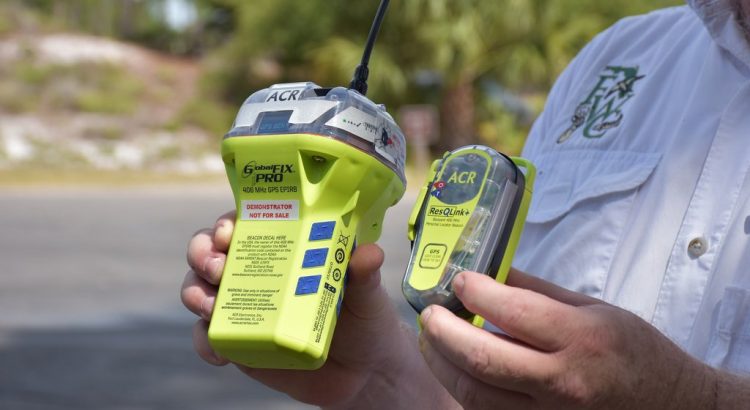Types of emergency locator beacons [ edit ] 379
by Admin
Posted on 02-11-2023 11:30 AM

An
emergency
position-indicating radiobeacon (epirb) is a type of emergency locator beacon for commercial and recreational boats, a portable, battery-powered radio transmitter used in emergencies to locate boaters in distress and in need of immediate rescue. In the event of an emergency, such as a ship sinking or medical emergency onboard, the transmitter is activated and begins transmitting a continuous 406 mhz distress radio signal, which is used by search-and-rescue teams to quickly locate the emergency and render aid.
 The signal is detected by satellites operated by an international consortium of rescue services, cospas-sarsat , which can detect emergency beacons anywhere on earth transmitting on the distress frequency of 406 mhz.
The signal is detected by satellites operated by an international consortium of rescue services, cospas-sarsat , which can detect emergency beacons anywhere on earth transmitting on the distress frequency of 406 mhz.
Epirb is one of three main types of radio beacons that are used in emergency situations for search and rescue. Epirbs (emergency position indicating radio beacons) for maritime use elts (emergency locator transmitters) for aviation use plbs (personal locator beacons) for personal use (in a remote environment) all of them - epirbs, elts and plbs - operate within a satellite-based system at a frequency of 406 megahertz. This frequency has been designated internationally for use only in distress. Also, emergency beacons should be equipped with a 121. 5 mhz radio transmitter. A low-power 121. 5 mhz homing signal is used to guide rescue services when they are within 10 miles away from the beacon.
Search-and-rescue response [ edit ]
All boatu. S. Foundation epirbs are the 406 mhz model and uses the cospas/sarsat system of polar orbiting satellites.
 The advantages of a 406 epirb are worldwide coverage, position location accuracy, a reliable transmitted signal, an encoded message that identifies the distressed vessel, and a faster response
time
. For long offshore trips, a 406 epirb is the way to go. A gps enabled 406 epirb's accuracy is roughly within 100 yards of the initial alert which is a vast improvement from the old 121. 5 mhz epirbs. Once registered and in the event of an activation, the unique encoded digital message is received by the satellites are then transmitted back to ground-based search and rescue authorities.
The advantages of a 406 epirb are worldwide coverage, position location accuracy, a reliable transmitted signal, an encoded message that identifies the distressed vessel, and a faster response
time
. For long offshore trips, a 406 epirb is the way to go. A gps enabled 406 epirb's accuracy is roughly within 100 yards of the initial alert which is a vast improvement from the old 121. 5 mhz epirbs. Once registered and in the event of an activation, the unique encoded digital message is received by the satellites are then transmitted back to ground-based search and rescue authorities.
Plbs are smaller land-based cousins of emergency position indicating radio beacons (epirbs) used by boaters. When you activate a plb, it transmits a powerful distress signal that’s received by a global system of satellites. In the u. S. , those distress signals are monitored by noaa (national oceanic and atmospheric administration). After receiving your transmission, the satellite system relays your distress call to a network of response agencies, which ultimately results in your plea for assistance reaching a local search and rescue organization. Plbs also utilize another satellite network to get a location fix. In addition, most plbs today can provide rescuers with gps-provided coordinates to pinpoint your location even more precisely.
Once switched on (activated), an epirb transmits a signal which will be picked up by satellites within the international cospas-sarsat search and rescue satellite system. Satellites receive signals sent on the 406 mhz frequency, the standard international frequency for distress beacons. The satellite retransmits the signal to the nearest ground receiving station (local user terminal) which then sends the signal to the closest mcc (mission control centre). The mcc analyses the signal and sends it to the responsible rcc. In new zealand’s search and rescue region, this is the rccnz based in lower hutt. When they receive a signal, the rccnz begins a search and rescue response.
Emergency Locator Transmitters [ edit ]
The international cospas-sarsat system ceased satellite processing of 121. 5/243 mhz beacons on 1 february 2009. Although emergency locator transmitters used by aircraft may still be used, alerts from these devices or from 121. 5/243 mhz epirbs will no longer be acted upon unless independently confirmed by two independent non-satellite sources. These class a, class b, and class s devices are no longer allowed to be manufactured, imported, used or sold within the united states. Please see 47 cfr §80. 1053 prohibition on class a, class b, class s, and inmarsat-e epirbs.
Emergency locator transmitters (elts) are designed for aircraft. In some cases, emergency position indicating radio beacons (epirbs) or personal locator beacons (plbs) may be carried in place of an elt. Refer to casa to read the regulations.